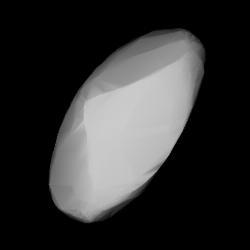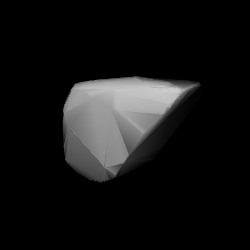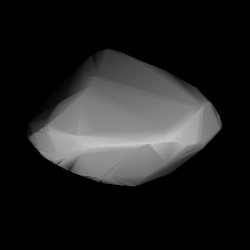2023 Asaph, provisional designation 1952 SA, is a dark asteroid from the outer regions of the asteroid belt, approximately 21 kilometers in diameter. It was discovered on 16 September 1952, by astronomers of the Indiana Asteroid Program at Goethe Link Observatory in Indiana, United States.
1015 Christa, provisional designation 1924 QF, is a dark background asteroid from the outermost regions of the asteroid belt, approximately 96 kilometers in diameter. It was discovered on 31 January 1924, by German astronomer Karl Reinmuth at the Heidelberg-Königstuhl State Observatory in southwest Germany. The meaning of this asteroids's name is unknown.
6433 Enya, provisional designation 1978 WC, is a stony background asteroid from the inner regions of the asteroid belt, approximately 7 kilometers in diameter. It was discovered on 18 November 1978, by Czech astronomer Antonín Mrkos at the Kleť Observatory in the Czech Republic. It was named for Irish musician Enya.

2839 Annette is a bright Flora asteroid from the inner regions of the asteroid belt. It was discovered on 5 October 1929, by American astronomer Clyde Tombaugh at Lowell Observatory during his search for Pluto. The presumed S-type asteroid has a rotation period of 10.5 hours and measures approximately 5 kilometers in diameter. It was named after the discoverer's daughter.
2637 Bobrovnikoff, provisional designation A919 SB, is a background asteroid from the inner regions of the asteroid belt, approximately 6 kilometers in diameter. It was discovered on 22 September 1919, by German astronomer Karl Reinmuth at the Heidelberg-Königstuhl State Observatory in Heidelberg, Germany. The presumed spherical S-type asteroid has a rotation period of 4.79 hours. It is named after astronomer Nicholas Bobrovnikoff, who was the director of the Perkins Observatory in Ohio, United States.

1555 Dejan, provisional designation 1941 SA, is an asteroid from the background population of the central regions of the asteroid belt, approximately 22 kilometers in diameter. It was discovered on 15 September 1941, by Belgian astronomer Fernand Rigaux at the Royal Observatory of Belgium in Uccle. The asteroid was named after Dejan Đurković, son of Serbian astronomer Petar Đurković.
9298 Geake, provisional designation 1985 JM, is a Mitidika asteroid from the central regions of the asteroid belt, approximately 12 kilometers in diameter. It was discovered on 15 May 1985, by American astronomer Edward Bowell at Lowell Observatory's Anderson Mesa Station near Flagstaff, Arizona, United States. The asteroid was named for British astronomer John E. Geake.
2571 Geisei, provisional designation 1981 UC, is a stony Florian asteroid from the inner regions of the asteroid belt, approximately 6 kilometers in diameter. It was discovered by Japanese astronomer Tsutomu Seki at Geisei Observatory on 23 October 1981, and named for the Japanese village of Geisei.
3353 Jarvis, or by its provisional designation, 1981 YC, is a carbonaceous Hungaria asteroid, slow rotator and suspected tumbler from the inner regions of the asteroid belt, approximately 10 kilometers in diameter.
6255 Kuma, provisional designation 1994 XT, is a carbonaceous asteroid from the central region of the asteroid belt, approximately 22 kilometers in diameter. It was discovered on 5 December 1994, by Japanese astronomer Akimasa Nakamura at Kuma Kogen Astronomical Observatory on the Island of Shikoku, Japan. It was named after the Japanese town of Kumakōgen.
3066 McFadden, provisional designation 1984 EO, is a stony background asteroid from the central regions of the asteroid belt, approximately 15 kilometers in diameter. It was discovered on 1 March 1984, by American astronomer Edward Bowell at the Anderson Mesa Station near Tucson, Arizona. It was named for American planetary scientist Lucy-Ann McFadden. The assumed S-type asteroid has a rotation period of 13.8 hours.
2043 Ortutay, provisional designation 1936 TH, is a dark asteroid from the outer regions of the asteroid belt, approximately 45 kilometers in diameter. The asteroid was discovered by Hungarian astronomer György Kulin at the Konkoly Observatory, Budapest, on 12 November 1936. It was named after Hungarian ethnographer Gyula Ortutay.

1436 Salonta, provisional designation 1936 YA, is a dark background asteroid from the outer regions of the asteroid belt, approximately 60 kilometers in diameter. Discovered by György Kulin at the Konkoly Observatory in 1936, the asteroid was later named for the Romanian city of Salonta, the birthplace of the discoverer.

1854 Skvortsov (prov. designation: 1968 UE1) is a stony background asteroid and relatively slow rotator from the middle region of the asteroid belt, approximately 9 kilometers in diameter. It was discovered on 22 October 1968, by Russian astronomer Tamara Smirnova at the Crimean Astrophysical Observatory in Nauchnyj on the Crimean peninsula. It is named after astronomer Evgenii Skvortsov.
1323 Tugela, provisional designation 1934 LD, is a dark background asteroid from the outer regions of the asteroid belt, approximately 60 kilometers in diameter. It was discovered on 19 May 1934, by South African astronomer Cyril Jackson at the Union Observatory in Johannesburg. The asteroid was named for the Tugela River in western South Africa.

1186 Turnera, provisional designation 1929 PL, is a stony Eoan asteroid from the outer regions of the asteroid belt, approximately 36 kilometers in diameter. It was discovered on 1 August 1929, by South African astronomer Cyril Jackson at the Union Observatory in Johannesburg. The asteroid was later named after British astronomer Herbert Hall Turner.
23712 Willpatrick is a stony Phocaea asteroid from the inner regions of the asteroid belt, approximately 5 kilometers in diameter.
3823 Yorii, provisional designation 1988 EC1, is a carbonaceous asteroid from the outer region of the asteroid belt, approximately 11 kilometers in diameter.

1546 Izsák, provisional designation 1941 SG1, is a background asteroid from the outer regions of the asteroid belt, approximately 27 kilometers in diameter. It was discovered on 28 September 1941, by Hungarian astronomer György Kulin at the Konkoly Observatory near Budapest, Hungary. The asteroid was named after Hungarian astronomer Imre Izsák.
8026 Johnmckay, provisional designation 1991 JA1, is a binary Hungaria asteroid and very slow rotator from the inner regions of the asteroid belt, approximately 2 kilometers in diameter. It was discovered on 8 May 1991, by American astronomer Eleanor Helin at the U.S. Palomar Observatory, California, and later named for NASA test pilot John B. McKay.







